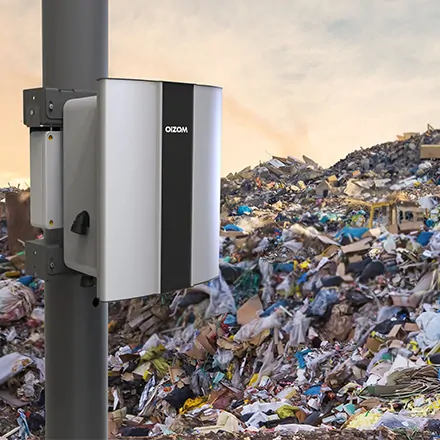Odour is a perception of smell, it may range from an unpleasant odour (like the rotten smell of garbage) to a pleasant one (fragrance). The effect of odour varies from person to person, but at significantly higher concentrations, harmful odours may have a direct effect on human health. It generally leads to vomiting, headaches, nausea, stress, anxiety, frustration, restriction in outdoor activities.
As per official estimates, around 62 million tonnes of solid waste is generated every year, and by 2030, it is expected to reach 165 million tonnes. Of the 62 million tonnes, 43 million tonnes are collected, and only 12 million tonnes are treated. This means the rest 31 million tonnes go untreated and are dumped in landfill sites, and this number is expected to grow as the total amount of waste increases.
Degradation of waste at landfills and dumpyards generates gases like Ammonia (NH3), Hydrogen Sulfide (H2S), SOx, NOx, Total Volatile Organic Compounds (TVOCs), Methane (CH4), Methyl Mercaptan, etc. therefore, it becomes mandatory for some odour management system to be in place for landfills and dumpyards.
The mismanagement of waste in these landfills gives rise to harmful and odourful gaseous contaminants. The World Health Organization recognizes these odours as pollution and says it affects the quality of life and social well-being of individuals.
So, How to Tackle This Situation?
Real-time odour monitoring is the answer. Monitoring odour emission can help in identifying the source and implement controls. Odour Monitor is an electronic nose that detects and measures the foul smell and the consequent gaseous components present in the ambient air.
Here are some of the features of an online odour monitoring system which can help in identifying the odour, assessing the situation, and implementing solutions to eradicate the problem:
1. On-Time Identification
Tracking odour emission from landfills in real-time can help in immediate identification of the major sources and the combined gases being released. This helps in assessing the present emission rates and addressing it, rather than analyzing the cumulative data over a period, which does not give an accurate picture of the problem.
2. Chemical Characterization
Odours generated from the gaseous compounds from landfill waste are usually Ammonia, Hydrogen Sulfide and VOCs (Volatile Organic Compounds) like amines, Mercaptans, Sulfur Compounds, Aldehydes, Ketones, Hydrocarbons, Chlorinated Compounds, Alcohols, etc.
Installing a network of e-noses (gas sensors) in and around landfills can sample these uprising gases and immediately provide composition analysis. Through this, an apt solution can be implemented to suppress the particular odour being generated.
3. Source Identification
Gases from the waste arise for a number of reasons – waste composition (in particular, its organic fraction (OFMSW)), decomposition stage, the rate of gas generation and the nature of microbial populations within the waste. It can be difficult to know precisely the source of odour emission without a proper monitoring system. Odour monitors can identify hot spots through hyperspatial data collection and plume dispersion modelling. Monitoring odour emission can help in identifying the root cause and implementing the correct solution to avoid maintenance and financial loss.
4. Dynamic Weather Conditions
Apart from the reasons listed above, the landfill emission is also impacted by weather conditions like wind speed and direction, temperature, pressure, humidity. Dynamic weather can diffuse the emission and affect the extension of the area in which odours spread away from the landfill boundaries. Certain e-noses measure meteorological parameters through dispersion modelling as well, along with the gaseous composition.
5. Impact Analysis
The odourful emission diffused with wind can stray away and reach the nearby localities. It can create a nuisance among the residents when exposed for a prolonged period. These harmful gases even cause diseases like nausea, vomiting, infection, etc. Hence, tracing the emission can assist in identifying the impacted areas. The source of these gases (hot spot identification) can be determined by backtracking the emission using reverse modelling.
6. Community Monitoring
Creating a dense network of e-noses can encourage the community to take part in the initiative. Local people can be alerted of the nuisance and the danger posed by the gaseous emission from the landfills. The step can help in tracking the emission hotspot and also maintain odour inventories.
7. Maintaining Regulations and Guidelines
Most of the landfills do not follow the guidelines for solid waste management. These guidelines, if followed, suggest ways to reduce odour from landfills. Odour can be reduced by implementing measures, such as creating a buffer zone around landfills by establishing a regular odour monitoring system and identification of leaks, among others.
The purpose of landfill monitoring is to provide guidance on the design and implementation of an effective and efficient monitoring program which will allow an accurate assessment of the impact of the landfill on the surrounding environment.
8. Risk Assessment and Remedial Actions
As per CPCB, it is necessary to initiate legislative norms for creating baseline data on odour. This can not only help in maintaining emission inventory but also in assessing the risk associated with each of the gaseous constituents.
Manual monitoring is time-consuming; hence, there is a need for a gradual shift towards Continuous Odour Measurement Systems (sensor-based) if immediate remedial actions to be taken to mitigate the odour. A well-designed monitoring program will, in turn, allow for the early recognition of adverse environmental effects and facilitate rapid corrective action.
9. Odour Suppression
Data from the odour monitors can help in analyzing the odour pattern and trend. These patterns can, in turn, assist in deploying an odour suppression system around the landfill to mitigate the chances of odour dispersion in the neighboring residential areas.
Oizom’s Landfill Odour Monitoring Projects
1. Odour Monitoring in Kanjurmarg Dumpyard
Oizom assisted ESS Enviro to solve the perpetual problem of foul smell from Kanjurmarg Dumpyard, which was becoming detrimental to people residing near Vikhroli and Bhandup by installing Odosense e-noses. The solution provided real-time odour monitoring for source detection and impact analysis in the neighbourhood for immediate corrective measures.
2. Muj Mahuda Landfill Monitoring in Vadodara
Oizom Odosense was deployed on the Muj Mahuda landfill periphery for solid waste management. Odosense monitored all the gaseous emissions from the waste in real-time to identify the prime sources.
The landfilling of waste poses a potential long-term threat to the environment. It is, therefore, important to ensure that landfills monitored continuously so that they do not significantly harm the environment, endanger human health, create an unacceptable risk to water, soil, atmosphere, plants or animals, and create a nuisance through odours.
Hence, odour emission from landfills needs to be addressed. The need to provide continuous odour monitoring and maintenance plays a crucial role in landfill odour management by treating the source of the odour problem rather than masking it.






